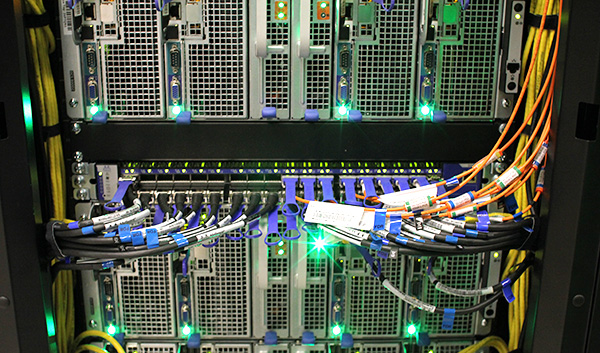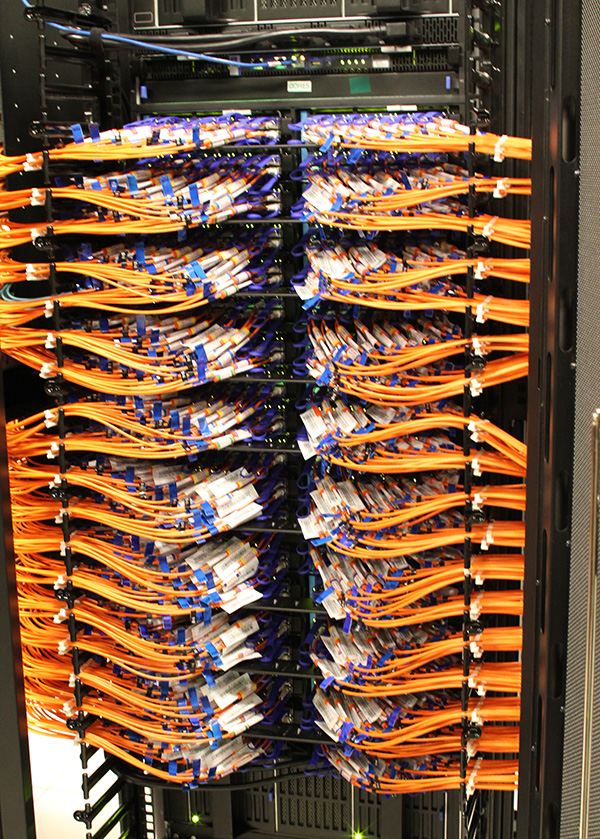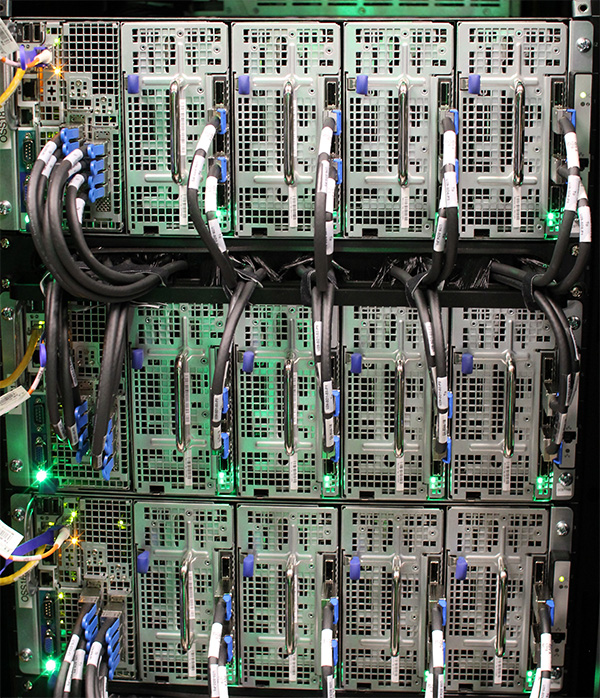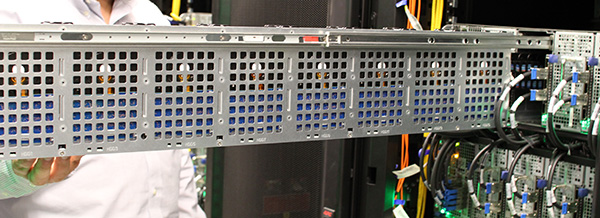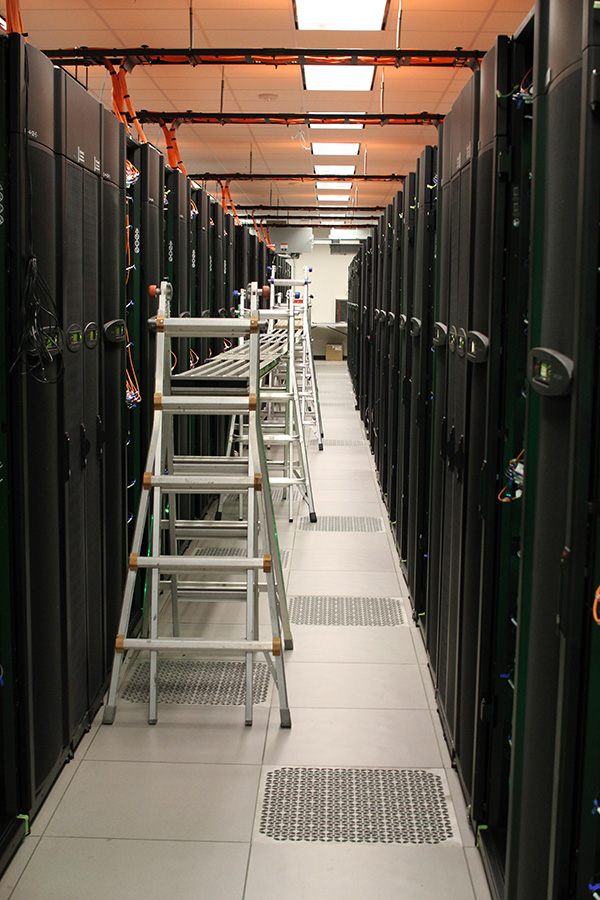Xeon Phi: Intel's Larrabee-Derived Card In TACC's Supercomputer
After eight years of development, Intel is finally ready to announce its Xeon Phi Coprocessor, which is derived from the company's work with Larrabee. Although the architecture came up short as a 3D graphics card, it shows more promise in the HPC space.
TACC's Stampede Supercomputer: Xeon Phi In The Field, Continued
Stampede Networking
In any system with multiple nodes, it's always a challenge to enable effective communication between them. With its remote direct memory access capabilities and low latency, TACC's Stampede takes advantage of Mellanox's 56 Gb/s InfiniBand interconnects. Fiber cables from the servers converge on an integrated switch in each rack.
Core switches tie everything together in the supercomputer. Here we see a Mellanox switch still being populated. Remember, Stampede is still under construction.
In case you're wondering, that large radius bend ensures the fiber optic cable does not kink. Given 75 miles worth of cabling, troubleshooting a problematic connection is not a simple proposition.
Fully populated, the switches look like this:
Stampede Data Storage
Those 2.5" drives found in each node don't have the capacity to hold the huge data sets a supercomputer works on, so dedicated storage nodes are folded into the mix.
Get Tom's Hardware's best news and in-depth reviews, straight to your inbox.
I was expecting to see rows of hot-swap drive trays, and was taken aback by the view above (at least until I was shown how the drives are configured).
Conventional 3.5" drives are arranged two-wide and eight-deep to provide more than 14 PB of Lustre storage to go along with the 270 TB of RAM. These shelves can be pulled out for drive swaps without disconnecting cables. It is actually a very elegant solution.
Thanks to the TACC and the University of Texas at Austin for graciously hosting the event and letting the press run all over Stampede.
Current page: TACC's Stampede Supercomputer: Xeon Phi In The Field, Continued
Prev Page TACC's Stampede Supercomputer: Xeon Phi In The Field Next Page A Look Into The Competition-
mocchan Articles like these is what makes me more and more interested in servers and super computers...Time to read up and learn more!Reply -
wannabepro Highly interesting.Reply
Great article.
I do hope they get these into the hands of students like myself though. -
ddpruitt Intriguing idea....Reply
These X86 cores have the uumph to run something a little more complex than what a GPGPU can. But is it worth it and what kind of effort does it require. I'd have to disagree with Intel's assertion that you can get used to it by programming for an "i3". Anyone with a relatively modern graphics card can learn to program OpenCL or CUDA on there own system. But learning how to program 60 cores efficiently (or more) from an 8 core (optimistically) doesn't seem reasonable. And how much is one of these cards going to run? You might get more by stringing a few GPUs together for the same cost.
I'm wonder if this is going to turn into the same time of niche product that Intel's old math-coprocessors did. -
CaedenV man, I love these articles! Just the sheer amounts of stuffs that go into them... measuring ram in hundreds of TBs... HDD space in PBs... it is hard to wrap one's brain around!Reply
I wonder what AMD is going to do... on the CPU side they have the cheaper (much cheaper) compute power for servers, but it is not slowing Intel sales down any. Then on the compute side Intel is making a big name for themselves with their new (but pricy) cards, and nVidia already has a handle on the 'budget' compute cards, while AMD does not have a product out yet to compete with PHI or Tesla.
On the processor side AMD really needs to look out for nVidia and their ARM chip prowess, which if focused on could very well eat into AMD's server chip market for the 'affordable' end of this professional market... It just seems like all the cards are stacked against AMD... rough times.
And then there is IBM. The company that has so much data center IP that they could stay comfortably afloat without having to make a single product. But the fact is that they have their own compelling products for this market, and when they get a client that needs intel or nvidia parts, they do not hesitate to build it for them. In some ways it amazes me that they are still around because you never hear about them... but they really are still the 'big boy' of the server world. -
A Bad Day esrevermehReply
*Looks at the current selection of desktops, laptops and tablets, including custom built PCs*
*Looks at the major data server or massively complex physics tasks that need to be accomplished*
*Runs such tasks on baby computers, including ones with an i7 clocked to 6 GHz and quad SLI/CF, then watches them crash or lock up*
ENTIRE SELECTION IS BABIES!
tacoslavei wonder if they can mod this to run games...
A four-core game that mainly relies on one or two cores, running on a thousand-core server. What are you thinking? -
ThatsMyNameDude Holy shit. Someone tell me if this will work. Maybe, if we pair this thing up with enough xeons and enough quadros and teslas, we can connect it with a gaming system and we could use the xeons to render low load games like cod mw3 and tf2 and feed it to the gaming system.Reply -
mayankleoboy1 Main advantage of LRB over Tesla and AMD firepro S10000 :Reply
A simple recompile is all thats needed to use PHI. Tesla/AMD needs a complete code re write. Which is very very expensive .
I see LRB being highly successful. -
PudgyChicken It'd be pretty neat to use a supercomputer like this to play a game like Metro 2033 at 4K, fully ray-traced.Reply
I'm having nerdgasms just thinking about it.
